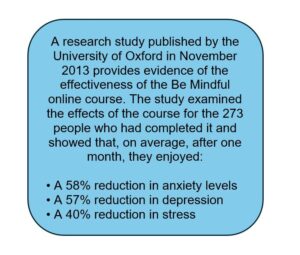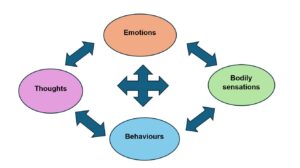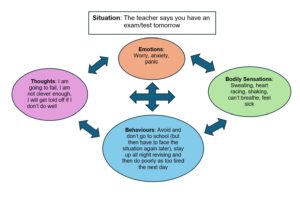Research has suggested benefits of mindfulness to health and wellbeing, with results showing positive effects on several aspects of whole-person health, including the mind, the brain, the body, and behaviour, as well as a person’s relationships with others.

Examples of Mindfulness
One-minute mindfulness
Mindfulness can be used in your everyday life and doesn’t have to take a lot of effort or time. You can practise mindfulness in just one minute!
Below are a few examples of one-minute mindfulness practices that you can try yourself anywhere and at any time that suits you.
Breathing
Take a minute to observe your breathing. Breathe in and out as you normally would: notice the time between each inhalation and exhalation; notice your lungs expanding. When your mind wanders, gently bring your attention back to your breath.
Body scan
It can often feel like we’re an observer of our own body caught up in our heads. Spend your one mindful minute bringing awareness to your body and your body’s sensations. Close your eyes and begin scanning your body. Start with your feet, and then slowly bring your awareness upwards in your body until you reach your hands. What sensations do you feel? Heaviness in the legs? Strain in the back? Perhaps no sensations at all. Now move your focus out from the hands and become aware of your environment and the space all around you.
Mindful walking
Mindful walking is something you can practise at any time as you go about your day. It’s good to try it slowly at first, but once you’re used to it, you can practise it at any pace – even when you’re rushing. Walk slowly: become aware of the sensations in the soles of your feet as they make contact with the floor, and any sensations in the muscles of the legs. You don’t have to look down at your feet. When your mind wanders, use the contact of the feet on the floor as an anchor to bring you back into the present moment. Just take a minute to focus on the sensations generated by walking.
Mindful listening
By taking this time out to tune in to your environment and listen to what it tells you, it will help you to bring mindfulness into the rest of your life – bringing your awareness as you move through the day. Take a minute to listen to the sounds in your environment. You don’t need to try and determine the origin or type of sounds you hear, just listen and absorb the experience of their quality and how it resonates with you. If you recognise a sound then label it and move on, allowing your ears to catch new sounds.
Recognising Thoughts.
The outside world can affect us and so our reactions to different situations, environments, social situations can be looked at using the model below.

We all have emotions (how we feel), thoughts (what we say to ourselves), bodily sensations (physical symptoms or feelings) and behaviours (our actions). It is important to understand that each of these interact and have an affect on each other. Have a look at the example below.

What your young person says to themself is called “self-talk”.
It is important for a young person to identify their self-talk, because persistent negative self-talk can lead to negative feelings which can lead to negative behaviour as shown earlier. Teaching young people that we can manage our own self-talk, can help them to control unhelpful thoughts.
Sometimes it can be difficult to understand the difference between a thought and a feeling. For example, the person may say their thought is “I’m scared” (which is actually a feeling) versus “that noise is a burglar trying to break in” (which is a real thought). It is important to expose the thoughts underneath the feelings!
Try asking questions like “what is making you scared? What do you think might be going on?”; this can help them (and you) identify the thought processes that are causing and maintaining the worry.




